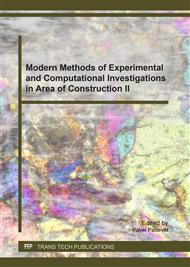[1]
S. Diamond, The microstructure of cement paste and concrete - a visual primer; Cem. Concr. Comp. 26 (2004) 919-933.
DOI: 10.1016/j.cemconcomp.2004.02.028
Google Scholar
[2]
H. M. Jennings, A model for the microstructure of calcium silicate hydrate in cement paste, Cement Concrete Res. 30 (2000) 101-106.
DOI: 10.1016/s0008-8846(99)00209-4
Google Scholar
[3]
F. J. Ulm, M. Vandamme, C. Bobko, J. A. Ortega, K. Tai, C. Ortiz, Statistical indentation techniques for hydrated nanocomposites: concrete, bone, and shale; J. Am. Ceram. Soc. 90 (2007) 2677-2692.
DOI: 10.1111/j.1551-2916.2007.02012.x
Google Scholar
[4]
G. Constantinides, F.J. Ulm, The effect of two types of C-S-H on the elasticity of cement-based materials: results from nanoindentation and micromechanical modeling, Cement Concrete Res. 34 (2004) 67-80.
DOI: 10.1016/s0008-8846(03)00230-8
Google Scholar
[5]
G. Constantinides, K. R. Chandran, F. - J. Ulm, K. V. Vliet, Grid indentation analysis of composite microstructure and mechanics: Principles and validation, Mater. Sci. Eng. A 430 (2006) 189-202.
DOI: 10.1016/j.msea.2006.05.125
Google Scholar
[6]
J. Němeček, J. Vondřejc, V. Králík, Micromechanical analysis of heterogeneous structural materials, Cem. Concr. Comp. 36 (2013) 85-92.
DOI: 10.1016/j.cemconcomp.2012.06.015
Google Scholar
[7]
J. Sanahuja, L. Dormieux, G. Chanvillard, Modeling elasticity of a hydrating cement paste, Cement Concrete Res. 37 (2007) 1427-1439.
DOI: 10.1016/j.cemconres.2007.07.003
Google Scholar
[8]
C. J. Haecker, E. J. Garboczi, J. W. Bullard, R. B. Bohn, Z. Sun, S. P. Shah, T. Voigt, Modeling the linear elastic properties of Portland cement paste, Cement Concrete Res. 35 (2005) 1948-(1960).
DOI: 10.1016/j.cemconres.2005.05.001
Google Scholar
[9]
C. Jolicoeur, M. A. Simard, Chemical admixture-cement interactions: Phenomenology and physico-chemical concepts, Cem. Concr. Comp. 20 (1998) 87-101.
DOI: 10.1016/s0958-9465(97)00062-0
Google Scholar
[10]
A. M. Paillere, Application of Admixtures in Concrete (RILEM Report 10), first ed., E & FN Spon, London, (1994).
Google Scholar
[11]
V. S. Ramachandran , Concrete Admixtures Handbook, 2 nd Ed.: Properties, Science and Technology, Noyes Publications, New Jersey, (1996).
Google Scholar
[12]
W. C. Oliver, G. M. Pharr, Measurement of hardness and elastic modulus by instrumented indentation: Advances in understanding and refinements to methodology, J. Mater. Res. 19 (2004) 3-20.
DOI: 10.1557/jmr.2004.19.1.3
Google Scholar
[13]
H. Hertz, Über die berührung fester elastischer Körper (On the contact of rigid elastic solids), Miscellaneous Papers, J. Reine und Angewandte Mathematik 92, Macmillan, London, 1896, p.156.
DOI: 10.1515/9783112342404-004
Google Scholar
[14]
J. L. Hay, G. M. Pharr, Instrumented indentation testing, ASM Handbook, Vol. 8: Mechanical Testing and Evaluation, 10th ed., ASM International, 2000, pp.232-243.
DOI: 10.31399/asm.hb.v08.a0003273
Google Scholar
[15]
K. Velez, S. Maximilien, D. Damidot, G. Fantozzi, F. Sorrentino, Instrumented Determination by nanoindentation of elastic modulus and hardness of pure constituents of Portland cement clinker, Cement Concrete Res. 31 (2001) 555-561.
DOI: 10.1016/s0008-8846(00)00505-6
Google Scholar


